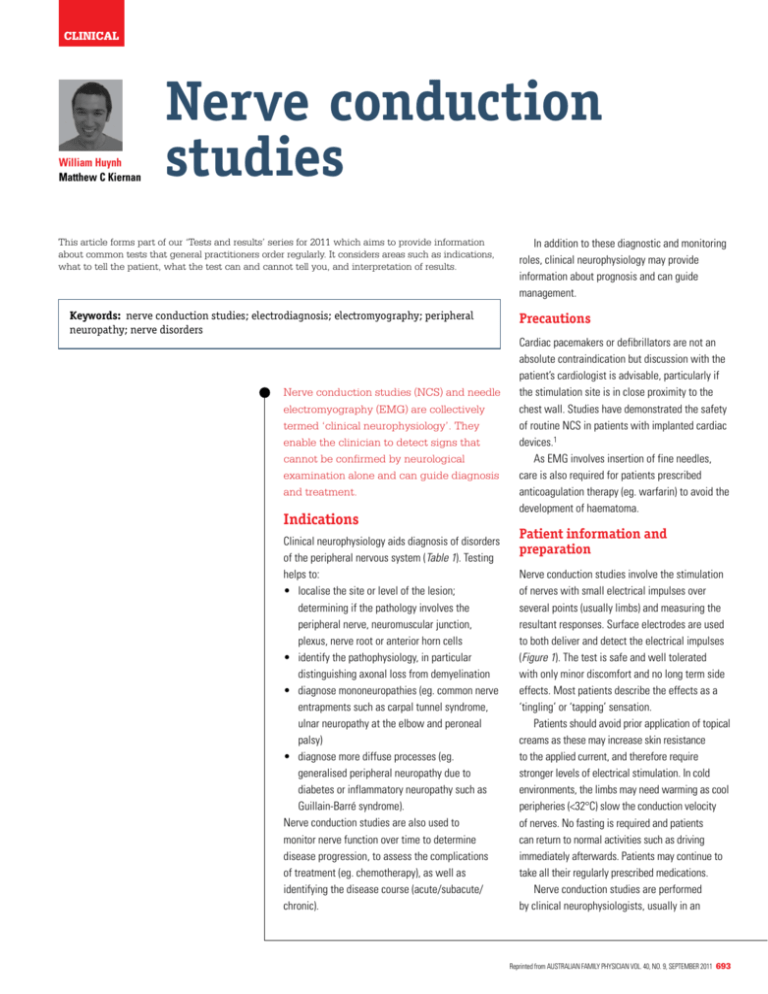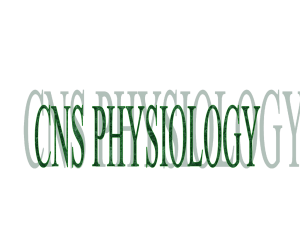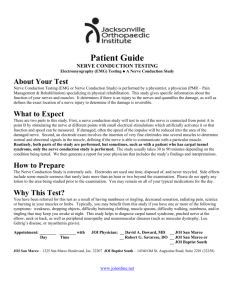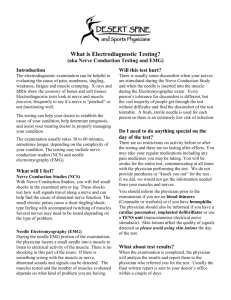Nerve conduction studies
advertisement

clinical William Huynh Matthew C Kiernan Nerve conduction studies This article forms part of our ‘Tests and results’ series for 2011 which aims to provide information about common tests that general practitioners order regularly. It considers areas such as indications, what to tell the patient, what the test can and cannot tell you, and interpretation of results. Keywords: nerve conduction studies; electrodiagnosis; electromyography; peripheral neuropathy; nerve disorders Nerve conduction studies (NCS) and needle electromyography (EMG) are collectively termed ‘clinical neurophysiology’. They enable the clinician to detect signs that cannot be confirmed by neurological examination alone and can guide diagnosis and treatment. Indications Clinical neurophysiology aids diagnosis of disorders of the peripheral nervous system (Table 1). Testing helps to: • localise the site or level of the lesion; determining if the pathology involves the peripheral nerve, neuromuscular junction, plexus, nerve root or anterior horn cells • identify the pathophysiology, in particular distinguishing axonal loss from demyelination • diagnose mononeuropathies (eg. common nerve entrapments such as carpal tunnel syndrome, ulnar neuropathy at the elbow and peroneal palsy) • diagnose more diffuse processes (eg. generalised peripheral neuropathy due to diabetes or inflammatory neuropathy such as Guillain-Barré syndrome). Nerve conduction studies are also used to monitor nerve function over time to determine disease progression, to assess the complications of treatment (eg. chemotherapy), as well as identifying the disease course (acute/subacute/ chronic). In addition to these diagnostic and monitoring roles, clinical neurophysiology may provide information about prognosis and can guide management. Precautions Cardiac pacemakers or defibrillators are not an absolute contraindication but discussion with the patient’s cardiologist is advisable, particularly if the stimulation site is in close proximity to the chest wall. Studies have demonstrated the safety of routine NCS in patients with implanted cardiac devices.1 As EMG involves insertion of fine needles, care is also required for patients prescribed anticoagulation therapy (eg. warfarin) to avoid the development of haematoma. Patient information and preparation Nerve conduction studies involve the stimulation of nerves with small electrical impulses over several points (usually limbs) and measuring the resultant responses. Surface electrodes are used to both deliver and detect the electrical impulses (Figure 1). The test is safe and well tolerated with only minor discomfort and no long term side effects. Most patients describe the effects as a ‘tingling’ or ‘tapping’ sensation. Patients should avoid prior application of topical creams as these may increase skin resistance to the applied current, and therefore require stronger levels of electrical stimulation. In cold environments, the limbs may need warming as cool peripheries (<32°C) slow the conduction velocity of nerves. No fasting is required and patients can return to normal activities such as driving immediately afterwards. Patients may continue to take all their regularly prescribed medications. Nerve conduction studies are performed by clinical neurophysiologists, usually in an Reprinted from Australian Family Physician Vol. 40, No. 9, SEPTEMBER 2011 693 clinical Nerve conduction studies Table 1. Common conditions referred to clinical neurophysiology Level of lesion(s) Peripheral nerve entrapment syndromes Common disorder Carpal tunnel syndrome Ulnar neuropathy at elbow Polyneuropathy Plexus Nerve root Peroneal palsy at fibular neck • Metabolic (eg. diabetes) • Toxic (eg. alcohol) • Medications (eg. chemotherapy) • Hereditary Brachial plexus (eg. brachial neuritis) Cervical radiculopathy Lumbosacral radiculopathy Anterior horn cell (‘neuronopathy’) Neuromuscular junction Motor neuron disease (amyotrophic lateral sclerosis) Myasthenia gravis Muscle Inflammatory myopathies (eg. polymyositis) Common presenting symptoms Sensory disturbance of hands and fingers with nocturnal exacerbation Sensory disturbance of digits four/five; weakness and wasting of intrinsic hand muscles Foot drop Length dependent sensory and/or motor impairment Unilateral shoulder pain with sensory disturbance and weakness in upper limb Neck and upper limb pain; sensory disturbance and weakness in arm/hand/fingers Lower back pain; sciatica type symptoms and weakness in lower limb Progressive limb weakness; bulbar weakness; muscle fasciculations Fatiguable proximal weakness; diplopia; bulbar weakness Proximal muscle weakness and myalgia; elevated serum creatine kinase outpatient rooms setting. Typically, NCS take between 15 minutes and an hour, depending on the number of sites requiring testing and the complexity of the clinical presentation. A Medicare rebate is available for the study and varies depending on the complexity of the study and the number of nerves examined. Sensory, motor or mixed nerves can be studied. Pairs of electrodes are used – one to initiate the impulse and the other to record the response further along the path of the nerve (distally within the innervated muscle for motor nerves or proximally along sensory nerves). For motor nerves, a depolarising square wave current is applied to the peripheral nerve to produce a compound muscle action potential (CMAP) due to summation of the activated muscle fibres. In sensory nerves, a propagated sensory nerve action potential (SNAP) is created in a similar manner. The parameters obtained and used for interpretation include (Figure 1): • amplitude – from baseline to peak (reflects the number of conducting fibres and is reduced in axonal loss) 694 Reprinted from Australian Family Physician Vol. 40, No. 9, SEPTEMBER 2011 distance (elbow-wrist) Conduction = velocity latency (elbow) – latency (wrist) Eg. CV = Amplitude Principles of nerve conduction studies 250 mm = 55.6 m/s 7.5 ms –3 ms Peak 5 mV 3 ms Duration Onset latency Wrist Elbow • latency (ms) – from stimulus to onset of evoked response • duration of response (ms) • conduction velocity (m/s) – calculated from the distance between stimulation and recording points, divided by latency (reflects integrity of the myelin sheath important for impulse Figure 1. Motor conduction study of the median nerve with recording electrodes over the abductor pollicis brevis muscle and resultant CMAP responses following stimulation of the nerve at the wrist and elbow conduction, and is reduced in demyelinating processes). Late responses Late responses can be used to assess more proximal segments of the peripheral nervous system, such as the plexus and nerve roots. Nerve conduction studies clinical 2 mV 5 ms Wrist Elbow Figure 2. Median nerve CMAP recorded over abductor pollis brevis demonstrating temporal dispersion when stimulating at the wrist (top) and elbow (bottom) These proximal segments are not accessible by routine NCS techniques and is not possible to position the electrodes in close proximity to the spinal cord or its nearby structures. This is important as proximal segments may be the only site of pathology, for example, in radiculopathy due to disc protrusion or in polyradiculopathy from Guillain-Barré syndrome. Late responses also provide information about longer nerve pathways so may detect some conduction abnormalities that would not be identified on the shorter NCS range, particularly in diffuse or multisegmental disease processes. The late responses occur approximately 20–35 ms and 45–60 ms after stimulation in the upper and lower limbs respectively, and include the F waves (‘F’ for foot, the original recording site) and H reflexes (named after Hoffman who first described the reflex). F waves result from the backfiring of activated motor neurons when a supramaximal stimulus is applied at a point along the motor nerve. Essentially the impulse travels proximally up the motor axon from the site of initiation to the spinal cord. Here it activates a proportion of motor neurons, resulting in a delayed and smaller muscle response as the impulse travels back down the motor nerve. The H reflex, which is elicited by submaximal stimuli, is the electrical equivalent of a tendon jerk (or monosynaptic stretch reflex) and involves stimulation of a sensory axon to produce a delayed motor response. Amplitude is less relevant for late responses – useful parameters of F waves and H reflexes are their presence and minimal latencies. area/amplitude of at least 50% at a proximal compared to a distal site of stimulation). Conventional NCS may be unremarkable in the case of demyelinating diseases involving the more proximal segments (eg. Gillain-Barré syndrome), in which case, prolongation of the F wave and H reflex latencies may be the only abnormality. Electromyography Interpretation When interpreting NCS data, initial considerations are: • Is the compound potential normal in size and shape, or reduced? • Is the conduction velocity normal? Table 2 outlines key differences between NCS results in axonal loss and demyelinating processes. As a simple rule, axonal degeneration leads to a loss of amplitude and demyelination leads to prolonged conduction time. Axonal loss The most common abnormality is reduction in compound amplitude reflecting fewer functioning axons. With myelin relatively intact, the remaining axons conduct normally with normal latencies and conduction velocities. However, as axonal degeneration progresses, latencies can be mildly prolonged and conduction velocities slightly slowed because of loss of larger, fast conducting fibres. Demyelination Loss of myelin slows conduction which manifests as significant reduction in conduction velocities and temporal dispersion (increase in the duration). Conduction block can also occur (a reduction of Electromyography is typically undertaken in conjunction with NCS when more specific information is required. Electromyography is most commonly used to investigate weakness and helps distinguish myopathic from neurogenic causes. Fine needles are inserted into muscle fibres and then the patient is asked to contract these muscles. Electromyography enables assessment of the morphology of single motor units (neuron, axon and innervated muscle fibres) and the recruitment pattern of these units. Changes in EMG morphology reflect changes in the number and size of muscle fibres innervated by single motor axons. Neurogenic lesions typically demonstrate polyphasic large motor units with a reduced recruitment pattern, while myopathic motor units are small and polyphasic with early recruitment. Electromyography also enables the pattern of abnormality to be determined to assist in diagnosis and localisation of a lesion. The stage of the neurogenic lesion (acute, subacute or chronic) as well as its recovery, may also be assessed. Common indications that may necessitate EMG include: to diagnose myopathies, to differentiate between radiculopathy and peripheral nerve lesions, to localise the level of peripheral nerve or root lesions, and to detect widespread denervation that would be present in motor neuronopathies such as motor neuron disease. Table 2. Nerve conduction parameters observed in axonal degeneration or demyelination Axonal degeneration Demyelination Sensory or motor amplitudes Small or absent Normal or slightly reduced Distal latencies Normal Prolonged Conduction velocities Normal or slightly reduced Significantly reduced F wave latencies Normal or slightly prolonged Significantly prolonged or absent H reflex latencies Normal or slightly prolonged Significantly prolonged or absent Conduction block/temporal dispersion Not present Present Reprinted from Australian Family Physician Vol. 40, No. 9, SEPTEMBER 2011 695 clinical Nerve conduction studies Limitations, pitfalls and interpretation issues • NCS test large myelinated fibres corresponding to the sensory modalities of fine touch, vibration and proprioception. Small fibre neuropathies that present with pain may therefore have normal sensory studies. Other diagnostic tests such as quantitative sensory and autonomic testing may be required • Anomalous innervation, such as Martin-Gruber anastomosis in the upper limb, may complicate nerve conduction studies and its interpretation • Early in the course of disease (eg. GuillainBarré syndrome or carpal tunnel syndrome), changes may be relatively subtle and therefore missed. A repeat study may be required at a later time to confirm the diagnosis • Late responses provide some information about proximal segments of the peripheral nervous system, however, NCS may still miss disorders that only affect nerve roots or plexus. EMG may be useful in this situation • Reference values for comparison are derived from studies of neurologically ‘normal’ subjects frequently reported as 95% confidence limits. For this reason, the neurophysiologist may need to assess a number of parameters together with the relevant clinical information when interpreting the results • Nerve conduction varies across different age groups. This is particularly important when interpreting sural sensory responses in an older age group (>65 years) or paediatric patients where reference values are not well defined • As NCS results are highly context specific, tests ordered with a clear indication and specific clinical question will yield more useful information. Case study Jane, 45 years of age, presented with a 9 week history of progressive paraesthesia and weakness involving her fingers and feet bilaterally. She was otherwise well with no comorbidities or antecedent illness. Jane had no relevant family history and was not prescribed any medications. Neurological examination demonstrated moderate weakness in the distal limbs bilaterally associated with globally absent reflexes. 696 Reprinted from Australian Family Physician Vol. 40, No. 9, SEPTEMBER 2011 Sensory Nerve/sites Rec. site Amp. (µV) Reference range Velocity (m/s) Reference range (mean±SD) L sural Calf Lateral malleolus R sural Calf Lateral malleolus R radial (superficial) Snuff box Forearm 23 19±7 40.8 >40 24 19±7 41 >40 Absent 48±15 >50 Sensory studies were normal in the lower limbs but absent in the upper limbs. This ‘sural sparing’ pattern may typically be observed with acquired immune mediated neuropathies. Motor NCS Nerve/sites Latency (ms) Reference range Ampl. (mV) Reference range Velocity (m/s) Reference range 30.4 >40 24.8 >50 (mean±SD) L tibial malleolus – AH Ankle 6.80 Popliteal 19.15 fossa R median – APB Wrist 8.05 Elbow 16.10 <6 max <3.5 3.6 2.9 11.6±4.3 3.6 3.4 9.5±2.7 Motor studies demonstrated prolongation in the distal latencies (red) and reduction in the conduction velocities (blue), with only mild reduction in CMAP amplitudes. This is typical of a demyelinating process. The motor responses demonstrated temporal dispersion in the morphology of the potential (Figure 2 compared to the normal waveform in Figure 1). This is another hallmark of demyelination, where fibres conduct at different speeds due to myelin loss. F waves Nerve Min. F latency (ms) Reference range L tibial – AH R median – APB 81.85 67.05 (mean±SD) 52.3±4.3 29.1±2.3 Persist (%) 100 20 F waves in the upper and lower limbs were markedly prolonged in latency (green), suggesting a demyelinating process affecting the more proximal segments of the nerves. The reduced F wave persistence in the upper limbs (20%) suggested that only some of the responses were getting through indicating the presence of conduction block more proximally. Needle EMG demonstrated widespread acute and chronic neurogenic features in the upper and lower limbs. In total, the neurophysiological results were consistent with an acquired demyelinating polyradiculoneuropathy. Together with the clinical presentation and the duration of symptoms (>8 weeks), a diagnosis of chronic inflammatory demyelinating polyradiculoneuropathy (CIDP) was reached. Lumbar puncture demonstrated elevated cerebrospinal protein and normal white cell count (albumino-cytological dissociation) again consistent with CIDP. Jane was treated with interval intravenous immunoglobulins (IVIg) and made an excellent clinical and neurophysiological improvement. Figure 3. Jane’s nerve conduction study results Nerve conduction studies clinical Sensory examination did not reveal definite abnormalities. Jane’s nerve conduction study results, along with an accompanying explanation, are presented in Figure 3. Matthew C Kiernan MBBS, PhD, DSc, FRACP, is Professor of Medicine and Consultant Neurologist, Neuroscience Research Australia and Prince of Wales Clinical School, University of New South Wales, Sydney, New South Wales. Key points Conflict of interest: none declared. • Nerve conduction studies help determine at which level of the peripheral nervous system the pathology is located, and are useful for the diagnosis and monitoring of a number of focal and diffuse conditions. • Nerve conduction studies can help distinguish axon loss (loss of amplitude) from demyelinating conditions (slowed conduction). • Nerve conduction studies are safe and well tolerated but care is required in patients with a pacemaker or implantable defibrillator. • Late responses are an important indirect assessment of the proximal segments (nerve roots and plexus) and may be the only abnormality in many pathologies. • Interpretation of NCS is highly context specific, hence clear clinical information will yield more useful results. Reference 1. Schoeck AP, Mellion ML, Gilchrist JM, Christian FV. Safety of nerve conduction studies in patients with implanted cardiac devices. Muscle Nerve 2007;35:521–4. Further reading • Cheah BC, Kiernan MC. Neurophysiological methodologies: diagnosis of peripheral nerve disease and assessment of pharmacological agents. Curr Opin Investig Drugs 2010;11:72–9 • Fuller G. How to get the most out of nerve conduction studies and electromyography. J Neurol Neurosurg Psychiatry 2005;76 (Suppl 2):ii41–6 • Katirji B. The clinical electromyography examination. An overview. Neurol Clin 2002;20:291–303 • Kimura J. Facts, fallacies, and fancies of nerve conduction studies: twenty-first annual Edward H. Lambert Lecture. Muscle Nerve 1997;20:777–87 • Mallik A, Weir AI. Nerve conduction studies: essentials and pitfalls in practice. J Neurol Neurosurg Psychiatry 2005;76(Suppl 2):ii23–31 • MBS Online. Available at www.mbsonline.gov. au/internet/mbsonline/publishing.nsf/Content/ print-on-demand. Authors William Huynh MBBS, BSc, FRACP, is Consultant Neurologist, Clinical Neurophysiologist and Associate Lecturer, Neuroscience Research Australia and Prince of Wales Clinical School, University of New South Wales, Sydney, New South Wales. w.huynh@neura.edu.au Reprinted from Australian Family Physician Vol. 40, No. 9, SEPTEMBER 2011 697







